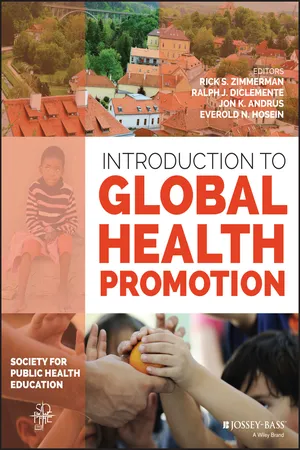
Introduction to Global Health Promotion
- English
- ePUB (mobile friendly)
- Available on iOS & Android
Introduction to Global Health Promotion
About This Book
Introduction to Global Health Promotion addresses a breadth and depth of public health topics that students and emerging professionals in the field must understand as the world's burden of disease changes with non-communicable diseases on the rise in low- and middle-income countries as their middle class populations grow. Now more than ever, we need to provide health advocacy and intervention to prevent, predict, and address emerging global health issues. This new text from the Society for Public Health Education (SOPHE) prepares readers with thorough and thoughtful chapters on global health promotion theories, best practices, and perspectives on the future of the field, from the individual to the global level. The world's biggest health care challenges—including HIV, malaria, heart disease, smoking, and violence, among others—are explored in detail in Introduction to Global Health Promotion. The state of the science, including the latest empirical data, is distilled into 19 chapters that update readers on the complex issues surrounding a variety of illnesses and conditions, and disease epidemics and individual, social, institutional, and governmental barriers to preventing them. Expert authors bring to the fore human rights issues, new uses of technology, and practical application of theory. These perspectives, along with the book's multidisciplinary approach, serve to create a well-rounded understanding of global health today. Learn more from the Editors of Introduction to Global Health Promotion here.
Frequently asked questions
Information
Chapter 1
The State of Global Health
Richard Skolnik
Learning Objectives
- Explain the concepts of “DALYs” and “burden of disease”
- Outline the leading causes of morbidity and mortality globally
- Discuss the main risk factors for the leading causes of morbidity and mortality
- Explain how the leading causes of morbidity and mortality and their risk factors vary by country income group, age, and sex
- Review broadly how health communication relates to the burden of disease and its risk factors
- How long do people live and how many of those years are lived in good health?
- What are the most important causes of morbidity?
- What are the most important causes of mortality?
- What are the most important risk factors associated with these leading causes of morbidity and mortality?
- How do morbidity and mortality and their associated risk factors vary across regions, countries, and groups?
- How have the leading causes of morbidity and mortality changed over time?
- How do we project that the leading causes of morbidity and mortality will change in the future?
A Note on Data Sources and Definitions
Table of contents
- Cover
- Title Page
- Copyright
- Table of Contents
- Dedication
- Preface
- Acknowledgments
- The Editors
- SOPHE
- The Contributors
- Chapter 1: The State of Global Health
- Chapter 2: Global Health Promotion: The State of the Science
- Chapter 3: Global Health Promotion and the Social Determinants of Health
- Chapter 4: Models of Health Behavior Change: International Applications
- Chapter 5: Two Health Communication Approaches: Communication for Behavioral Impact (COMBI) and Entertainment Education
- Chapter 6: Global Health Promotion in the Context of Human Rights
- Chapter 7: eHEALTH and Global Health Promotion
- Chapter 8: Reducing Maternal and Infant Mortality: Meeting a Global Challenge
- Chapter 9: Malaria Prevention and Control
- Chapter 10: Global Immunization Initiatives from a Health Promotion Perspective
- Chapter 11: The Evolving Global HIV Pandemic: Epidemiology, Prevention, and Future Priorities
- Chapter 12: Community-Based Risk Communication in Epidemics and Emerging Disease Settings
- Chapter 13: Noncommunicable Diseases (NCDs): Moving Toward Health Promotion
- Chapter 14: Women's Cancers
- Chapter 15: Health Promotion in Families and Communities: An Integrated Approach from Latin America and the Caribbean
- Chapter 16: Oral Health Promotion
- Chapter 17: Adaptation and Implementation of Public Health Innovations in Developing Countries
- Chapter 18: Health Promotion in the Global Setting: The Role of International Organizations and Governments
- Chapter 19: The Future of Global Health Promotion
- Author Index
- Subject Index
- End User License Agreement